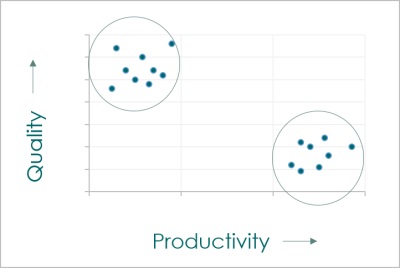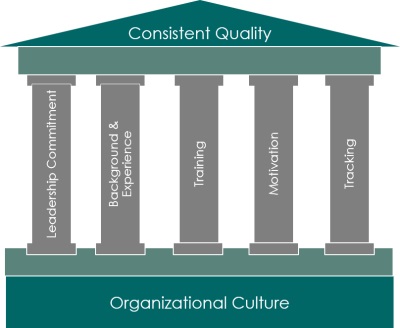INTRODUCTION
The attribute of quality in primary research largely stems from an underlying bedrock of organizational culture which supports several key determinants that defines quality as a consistent standard of performance. The merit and business value of research outputs can’t, however, just be secured by following an actions-oriented methodology. Certain characteristics need to be gradually cultivated within the organization’s very fabric to assimilate quality as way-of-life, till it becomes indistinguishable from the operational level functioning of processes. These characteristics make up the approach to quality. This is the mind-set that develops an understanding of what quality is for primary research, over the broad sweep of organizational functions. This overarching approach is complemented by certain material factors that drive quality within the organization and create the space for consistency in delivering it.
WHAT IS QUALITY IN PRIMARY RESEARCH – THE APPROACH
In primary-research, the attribute of quality is underscored by certain features that are inherent to the organizational DNA. This is embodied by the culture that surrounds this function within any market research entity. This undercurrent of culture ensures that the organization subscribes to a common mind-set, which shapes processes and directs operations with quality at their heart. This mind-set defines what quality is in primary research and what it does over the broad sweep of organizational functioning. While developing this mind-set definitely requires the assimilation of certain abstract features within the organization, some actionable elements necessarily make up the model approach. These are discussed in the following:-
- Produce Quality at Source
Primary research is essentially a people’s based operation, whereby, it falls upon the moderator to source knowledgeable respondents, provide intellectual stimulation, hold their attention in an engaging manner, and prompt them to share their mind during discussion. Therefore, the knowledge, preparation, and understanding as well as the attitude, choices, and instinct of moderator are paramount to quality. It goes without saying that having the right moderator would:-
(a) Ensure that they engage the right people,
(b) In the right manner,
(c) Be sensitive of the respondent’s time,
(d) Provide meaningful incentives,
(e) Secure comfort and peace of mind for the respondent
(f) Clearly explain the study’s objective and information sought, and
(g) Obtain the desired information.
The significance of quality moderators can’t be emphasized enough. Creating a team of knowledgeable and intuitive moderators lays the foundation for quality in primary research. Everything follows from there. The merit of moderators’ knowledge, mind-set, and efforts would undoubtedly be reflected in the quality of the research output. Interviewers with a seasoned sharpness of mind, sufficient preparation, and an instinctive spirit of enquiry will not only conduct research in an ethical and conscientious manner, but also go the extra-mile to ensure continuity and smooth functioning of the primary research process. Moreover, quality at source, i.e. excellence in the people, would also lend a sense of sanctity to data-handling associated with the primary research function.
A primary research function that can ensure extra-mile benefits – such as efficient knowledge and database management, direct referrals and request-circulation among professional networks from existing respondents, repeat engagements with key, niche, and hard-to-reach audiences, etc. – are assimilated into routine processes, not only provides for a continuity of process to clients but also ensures consistency in quality. All of this is possible by ensuring quality at source, i.e. in the moderators.
- Ensure Positive Experience for Respondents
It is crucial to the survival of market research, as an industry, that respondents of all manners and standing are willing to participate. Therefore, ensuring their comfort is crucial for enriching studies with the knowledge and experience that they possess. It is often the case that end-clients making use of research inputs get overly ambitious during the research planning stage, in the information that they would like to capture. At this stage it becomes difficult to put oneself in the shoes of the respondent, consequently, little thought is given to the interviewee’s level of comfort with the survey questionnaire. This is where the knowledge and experience of the market research agency becomes indispensable in determining quality of the engagement. It is important and, wouldn’t be any exaggeration to say that, it’s in the nature of the research vendor to ensure that:-
(a) The topic of research is engaging enough and is presented in a manner so as to pique the interest of the respondent,
(b) The sensitivity of information being captured from the respondents is respected,
(c) The research interview is conducted in a tasteful, decorous, and tactful manner, and
(d) The right number of questions are asked as part of the survey, so as to not overwhelm or, worse, frustrate the respondent,
Therefore, it falls upon agents of the market research organization to curtail the scope of the research survey, such that it satisfies requirements of the end-client, all the while securing a positive experience for the respondent. This is truly a hallmark of quality in the market research industry.
- Improvise Performance
In market research, quality is often thought of in isolation. Consequently, it comes up in variance with the interview quota numbers. This disconnect is quite apparent and, often, quality bears the brunt as pressure mounts for completing aggregate number in any project.
The modus operandi for ensuring quality of interviews is a checklist approach. This standard technique entails that a moderator who meets the requisite targeted levels on all parameters (set out in a checklist) is a skilful interviewer of sufficient caliber. The checklist approach ensures that the quality is as per, if not more than, the standard of expectations set by the organization. So, as an example, consider Scooby, who is a moderator. Now, given the fact that Scooby has to, has to meet the interview targets set out for him, he would tailor his approach so as to fulfil the bare minimum quality requirements set out in the checklist. This creates two lapses in quality:
(a) Scooby will not go beyond the bare minimum needed to secure the token of quality in his engagements and
(b) Scooby will not pay much heed to those attributes of quality that are not there in the checklist.
Therefore, as Scooby subscribes to a checklist approach, an assessment of the merits in his engagement will be reduced to certain measurable traits and indicators, while several subjective aspects would not be considered. This is why, true quality can’t be wholly realized through a checklist approach, which only ensures performance on the productivity scale.
If one were to plot all moderators for the quality of their engagements, using a checklist approach, versus their productivity in meeting targeted numbers, one would find a scatter plot where resources are found to be either high in quality and low in their productivity, or vice-versa. This, is the reason for the perception of quality as an isolated characteristic of the interview engagement. This creates a false impression that moderators can’t be both productive and principled in quality. However, this is only owing to the yardstick used to measure quality in the checklist approach. A more results driven approach to measuring quality which also takes into account qualitative measures would be greatly beneficial in creating a more comprehensive yardstick – a better measure of quality for the primary research resources. Hence, organizations need to refrain from a mind-set of just using a checklist-approach. This can be achieved by improvising, not compromising, on quality to meet quantitative targets.
WHAT DEFINES & DETERMINES QUALITY – THE DRIVERS
There are several material factors which determine quality under the larger umbrella of organizational culture. These drivers are embedded within the fabric of the organization’s functioning and provide for a blueprint to create processes which are driven by quality at their core. These aspects not only determine what quality looks like but also provide a roadmap for ensuring the same in a consistent and solemn manner.
At this point, it is important to underscore that quality in market research does not concern with incidental inflations or escalations in quality. Rather, it stems from a uniformity and regularity in the business value of the output. In keeping with this, the following attributes deliver systems and processes that ensure constancy in the quality of outputs. There are essentially five pillars of the organization which ensure consistent quality in the primary research function. These are underscored by a layer of organizational culture, which forms the foundational aspect for these drivers, discussed in the following:-
- Leadership’s Commitment
The issuance of a strategic roadmap for ensuring quality within the organization’s processes is a decisive factor for unbroken excellence in primary research. In order to drive quality within the organization, senior management needs to band together behind an overarching vision of what defines quality. They need to sponsor an approach to quality that directs quality initiatives according to a common strategic plan. The senior management should lead by examples, setting operational-level standards that embody the yardstick subscribed to by the organization, in principle. Moreover, resource allocation decisions must follow a clearly defined agenda, in line with the strategic outlook on quality. It has been a noted best-practice among high-performing research agencies that the quality and auditing functions are not only independent, but report directly to the leadership team.
- Background & Experience
Another key determinant for excellence in the primary research function are the people themselves. A selective hiring process that brings in the best talent and a structured system of evaluation and appraisal are the hallmark of quality, for this is essentially a people-driven industry. Moderators with sufficient finesse and poise, process-oriented managers with adequate experience, detail-oriented programming and data quality executives, as well as strict and unbiased, but fair and flexible quality control administrators, in themselves safeguard quality of research outputs. Stringent recruitment processes that check for honesty and integrity of candidates, in addition to attitude and aptitude tests, psychometric evaluation, as well as background and reference checks, deliver consistent excellence through a methodical approach.
- Training
Quality is a dissipative property and needs to be tended to on an ongoing basis. The skills of employees need to be constantly refreshed and processes cultivated through workshops, seminars, and trainings. The importance of a rigorous training process can’t be emphasized enough in this knowledge-based industry. A structured calendar of balanced and periodic trainings, which ensures that resources are up-to-date on trends and developments in the economy, at large, is a must for any research agency. These activities are important to developing well-rounded professionals who have adequate subject-matter understanding, follow clear and consistent techniques but are confident enough to improvise as the occasion requires, and work together as a team to ensure seamless quality in the primary research function. Linking the career path of moderators to performance in this sphere has been shown to have demonstrable influence on quality in their research outputs.
- Motivation
Again, since primary research is a people’s driven operation, it is fundamental to the quality of research outputs that the employees are instilled with a sense of pride. The importance of motivation among employees – particularly the moderators – can’t be emphasized enough. An organizational culture that ensures they take up work with inspiration, intellectual curiosity, and a sense of accomplishment, automatically translates the team’s collective energies into quality outputs, time and again. A clear path for career progression with measurable progress of employees along the curve, which they might be able to review and receive feedback over, coupled with a timely rewards and recognition program set the gold standard in this regard. Needless to say that quality resources must be requited with faster promotions and reappraised remuneration packages. A balanced approach to evaluation which weighs both, quality and productivity, to create a holistic picture of the resource provide for a well-rounded framework, which can deliver research outputs of consistent merit and business value.
- Tracking
Like we said before, quality is a dissipative property and needs to be tended on an ongoing basis. An approach to constantly monitor the quality of research outputs as well as the yardstick used for evaluation, is of paramount importance. A multidimensional undertaking in this regard, where quality is appraised from various perspectives and by different agents is advantageous, in that it provides for a 360° view. Starting from a process of self-evaluation, the tracking and monitoring can be supported by cross-examination at various levels of hierarchy to negate any biases. An autonomous quality control and auditing function within the organization provides for regular checks and balances which should be appended by external auditors. But what is perhaps most important, is the cultivation of internal mechanisms that create a culture of timely evaluation and continual improvement. An instance of such a system is lining up the KRA’s of supervisors and managers to, not just quality scores, but also self-evaluation. Ensuring quality throughout the primary research function calls for a process of automatic and perpetual evaluation, which ensures consistency through required course-correction and continual improvement.
CONCLUSION
Primary research being a people’s driven function, quality within it is a dissipative and somewhat volatile attribute. Hence, it requires constant treatment and attention, with an eye to consistently maintain a set standard of high-value research outputs. Consequently, an approach is required that starts with the subjective aspects of organizational culture and follows up with a concrete roadmap to constantly deliver on the standards set by the organization. Quality, as a defining feature of any researching agency, needs to be deeply embedded within the organization’s DNA and must, from there, be absorbed into operational level processes. While quality delivers through processes, it essentially stems from people and ensuring a right balance in how employees interact with organizational processes is the only secure way of guaranteeing consistent quality.





